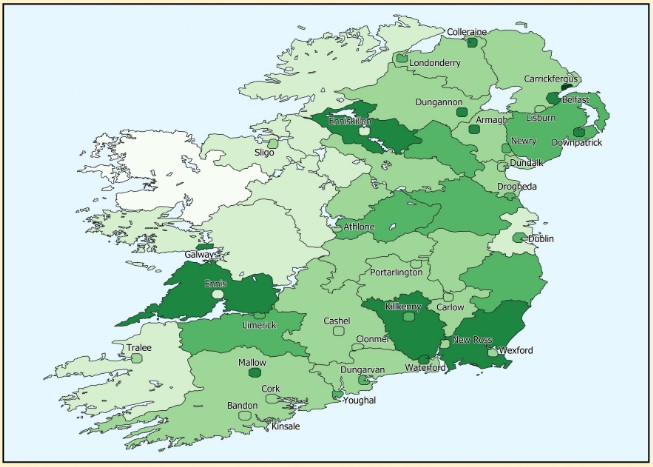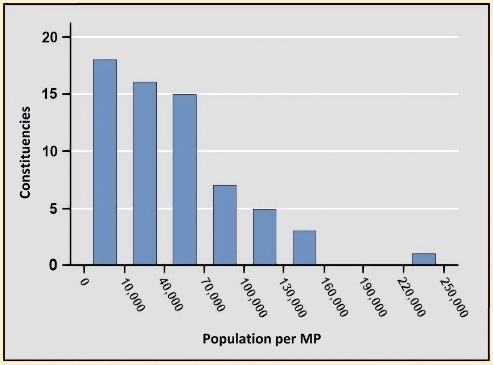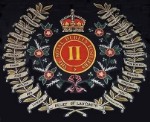UK General Election of 1857 in Ireland
The 1857 election turned on whether Henry John Temple (3rd Viscount Palmerston), the independent-minded leader of the Whigs, should remain as prime minister.
Palmerston was one of the UK's great landowners and had estates on both sides of the Irish Sea. He held nearly 14,000 acres of land in Co. Sligo, mostly of poor quality, 700 acres of valuable land in Co. Dublin, and 38 acres in Dublin City. He also owned 6,100 acres in Southampton (Hampshire), where he usually resided, and 1,300 acres in Yorkshire, the Temple ancestral land. The Sligo property consisted of about 1,350 acres mostly in Corran Barony (scattered about Ballymote) and 12,426 acres in Carbury Barony (three-fourths of the coastal Civil Parish of Ahamlish). In the 1860s, the Carbury land was assessed at £5,801 per annum (£0.46 per acre). The Dublin rural land was assessed at £5,362 (£7.66 per acre); the city land at £1,426. Palmerston died childless and his estates, except for the Ballymote land (previously sold), went to his stepson, William F. Cowper-Temple.
n/ John McKeon, "Lord Palmerston's Ballymote Estate," Corran Herald 52 (2019/2020): 8-13; Local Government Board (Ireland), Return of Owners of Land in Ireland, 1876, [C. 1492]; Local Government Board (England & Wales), Return of Owners of Land in England & Wales 1875, [C. 1097].
Temple was able to sit in commons as his aristocratic titles were Irish, created for his grandfather in 1722 by George I as King of Ireland. Temple was Viscount Palmerston, Co. Dublin and Baron Temple of Mount Temple, Co. Sligo.
n/ Thom's Almanac, 1859; John Lodge and Mervyn Archdall, The Peerage of Ireland, Vol. 5 (Dublin: Moore, 1789), 243-45. The creations were announced in the London Gazette of February 5-9, 1723.
The election gave the Whigs firm control of Commons by their winning 377 of that house's 654 seats. In Ireland, the Whigs returned 60 members, the Conservatives 45. Under the Whig umbrella was the Independent Irish faction of candidates endorsed by the Tenant Right League.
Conservatives were unopposed in the Counties of Carlow, Donegal, Fermanagh, Monaghan, and Tyrone; Boroughs of Bandon, Coleraine, Dungannon, and Enniskillen. There were three intra-party contests: Boroughs of Armagh, New Ross, and Portarlington.
Whigs were unopposed in the Counties of Kerry, Kildare, King's, Limerick, Meath, Roscommon, Tipperary, Waterford, and Westmeath; Boroughs of Clonmel, Cork City, Downpatrick, Ennis, Kinsale, Limerick City, Londonderry, Mallow, Tralee (Daniel O'Connell, son of "The Liberator"), and Youghal (Isaac Butt who would later found the Home Rule League). There were eight intra-party contests: Counties Galway, Kilkenny, and Longford; Boroughs of Dundalk, Galway, Kildare, Kilkenny, and Lisburn. All but two intra-party elections pitted Whig Regulars against Independent Irish. The Lisburn and Co. Longford elections were between Whig Regulars.
Note that the constituencies where Palmerston owned land (Co. Sligo, Co. Dublin, City of Dublin) all returned Conservative MPs.
In the General Election of 1900, voter party preference in Ireland was almost entirely dependent on the voter's religion. This was not the case in 1857; however, Conservatives generally did better in the counties with Protestant majorities (those that remained in the United Kingdom after 1921) than counties with Catholic majorities.
Results in Ireland, by Party
Seats in the House of Commons
County | Borough | University | Total | ||
Whig Regular | 27 | 20 | 47 | ||
Whig Independent Irish | 9 | 4 | 13 | ||
Total Whig | 36 | 24 | 60 | ||
Conservative | 28 | 15 | 2 | 45 |


Source: Brian M. Walker, ed., Parliamentary Election Results in Ireland 1801-1922 (Dublin: Royal Irish Academy, 1978).
Party Contested Elections
In the 1857 election, there were inter-party contests in only 24 of Ireland's 66 parliamentary constituencies. Such elections took place for 13 counties (26 MPs), 10 boroughs (13 MPs), and Dublin University (2 MPs). In all, only 41 of Ireland's 105 seats in Commons were contested by both political parties.
Each county returned two MPs while the urban boroughs returned one or two. Galway, Cork, Dublin, Waterford, and Belfast were the boroughs that elected two MPs. In the following tables, Conservative candidates are identified by C, Whig Regulars by W, and Whig Independent Irish by W-I. Winners are indicated by party colors (blue for Conservative, red for Whig).
Counties
Boroughs
University
Co. Antrim | ||
| Packenham | 4,686 | C |
| Macartney | 4,341 | C |
| O'Hara | 1,533 | W |
Co. Armagh | ||
| Close | 940 | C |
| Verner | 928 | C |
| Caulfield | 6 | W |
| Co. Cavan | ||
| Maxwell | 3,164 | C |
| Annesley | 2,164 | C |
| Dease | 1,409 | W |
Co. Derry | ||
| Clarke | 2,404 | C |
| Greer | 2,339 | W |
| Bruce | 1,676 | C |
Co. Down | ||
| Hill | 5,389 | C |
| Forde | 5,341 | C |
| Ker | 3,755 | W |
Co. Dublin | ||
| Hamilton | 2,451 | C |
| Taylor | 2,338 | C |
| Domvile | 1,659 | W |
| Co. Leitrim | ||
| Montgomery | 1,577 | C |
| Brady | 1,006 | W-I |
| Tenison | 591 | W |
Co. Louth | ||
| Fortescue | 1,376 | W |
| McClintock | 1,059 | C |
| Bellew | 894 | W |
| Kennedy | 406 | W-I |
Co. Mayo | ||
| Palmer | 1,225 | C |
| Moore | 1,159 | W-I |
| Higgins | 1,037 | W |
Queen's Co. | ||
| Coote | 1,856 | C |
| Dunne | 1,424 | W |
| Fitzpatrick | 1,239 | W |
Co. Sligo | ||
| Booth | 1,471 | C |
| Cooper | 1,471 | C |
| Ball | 305 | W |
| Swift | 5 | W-I |
| Co. Wexford | ||
| MacMahon | 4,306 | W-I |
| Hatchell | 2,870 | W |
| George | 2,522 | C |
Co. Wicklow | ||
| Milton | 1,970 | W |
| Hume | 1,610 | C |
| Monck | 1,030 | W |
Athlone | ||
| Ennis | 100 | W-I |
| Handcock | 50 | C |
| Belfast | ||
| Cairns | 1,479 | C |
| Davison | 1,410 | C |
| McClean | 995 | W |
| Ferguson | 733 | W |
| McClure | 566 | W |
| Carlow | ||
| Alexander | 127 | C |
| Ponsonby | 79 | W |
Carrickfergus | ||
| Dobbs | 560 | C |
| Macdonogh | 383 | W |
Cashel | ||
| O'Brien | 54 | W |
| Hemphill | 39 | C |
| Lanigan | 35 | W-I |
| Dublin | ||
| Grogan | 3,767 | C |
| Vance | 3,711 | C |
| Brady | 3,405 | W |
| Reynolds | 3,348 | W |
Dungarvan | ||
| Maguire | 123 | W-I |
| Humble | 104 | C |
Newry | ||
| Kirk | 246 | W |
| Waring | 232 | C |
| Sligo | ||
| Somers | 150 | W |
| Wynne | 144 | C |
Waterford | ||
| Blake | 519 | W-I |
| Hassard | 479 | C |
| Barron | 330 | W |
| Dwyer | 242 | W |
TCD | ||
| Napier | 829 | C |
| Hamilton | 791 | C |
Lawson | 272 | W |
| Wilson | 116 | W |
Voting Qualification
Overall, 11.9% of Irish males of age twenty-one and upwards could vote in Parliamentary elections. Voting eligibility for the 1857 election was determined by the Parliamentary Voting (Ireland) Act, 1850 (13 & 14 Vict., c. 69). Registered voters were termed "electors" and municipal officials compiled elector lists from property assessment records. County electors had to occupy land valued at least £12 per annum if leased, £5 if owned. Urban, parliamentary borough electors, had to occupy premises valued at least £8 per annum. Note that 52.0% of agricultural leaseholds were valued at under £8 and 12.8% were valued at £10 to £15.
n/ General Valuation (Ireland) Office, Return of Agricultural Holdings showing Area, Valuation, and Population, 1867, H.C. Accounts & Papers, No. 144, commonly known as "Griffith's Valuation" as at the time he headed the Irish Valuation Office.
For the University of Dublin constituency, all graduates holding a degree of masters or higher and the teaching staff were eligible to become electors. To qualify, such person had to pay the university £1 annually or make a single, lifetime payment of £5. The university maintained its elector roll.
n/ Samuel Lewis, A Topographical Dictionary of Ireland, Vol. 1 (London: Lewis, 1837), 552.
Voting was public and representatives of candidates and landlords typically monitored how electors voted. Voting by secret ballot took effect in 1872 pursuant to the Ballot Act, 35 & 36 Vict., c. 33. It's arguable whether open ballots deterred many Catholic electors from voting against the wishes of their landlords (or priests).
n/ Michael Hurst, "Ireland and the Ballot Act of 1872," The Historical Journal 8, no. 3 (1965): 326-52.
As shown in the map below, voter eligibility varied widely throughout Ireland. The Parliamentary Borough of Carrickfergus (in Co. Antrim) had the highest percentage of adult males as electors, 54.5%; Co. Mayo the lowest, 2.7%.
Eligible Voters as Percent Males Age 21+


Representation
In the mid-nineteenth century, the concept of "one man, one vote" was alien to the UK's electoral process. In Ireland, excluding the Dublin University MPs, a member of Commons could represent as few as 2,874 residents (MP for Portarlington, Queen's County) or as many as 221,187 (each of the MPs for Co. Cork). If all constituencies had the same population then each MP would represent about 55,000 residents. Based on the 1861 census, only 15 MPs represented from 40,000 to 70,000 residents while 18 represented fewer than 10,000. See the histogram below.
Distribution of Parliamentary Constituencies
Number of Residents per MP

As apparent from the map below, urban constituencies ("parliamentary boroughs") had the fewest residents per MP. An exception is the City of Dublin where two MPs represented 263,751 people (131,876 per MP).
Parliamentary representation varied considerably in Ireland by location. Generally, county MPs in Leinster represented fewer residents than county MPs in Ulster and Connaught. Representation within Munster varied greatly with Co. Cork MPs representing four times as many residents as Co. Waterford MPs (221,187 v. 52,731).
Constituents per MP


Download Map and Data Files
All the following files will download from this website, Major Tweedy's Neighborhood.
ESRI Shapefiles (Election_1857_IE.zip)
The vector layers (Districts_1857_Data, CitiesTowns) are compressed in the zip file (203kb). Districts_1857_Data is the set of polygon vector files for parliamentary constituencies and contains extensive data. CitiesTowns is a set of point vector files with the location of 161 towns and cities. Files were created using the WGS 84 coordinate reference system.
PDF (Election_1857_IE.pdf)
Adobe Acrobat portable document file of 1.8 MB.
Excel File (Election_1857.IE.xlsx)
A 23 kb file with names of MPs, party affiliation, constituency data (population, estimated males age 21+, electors), and votes in all contested elections.
